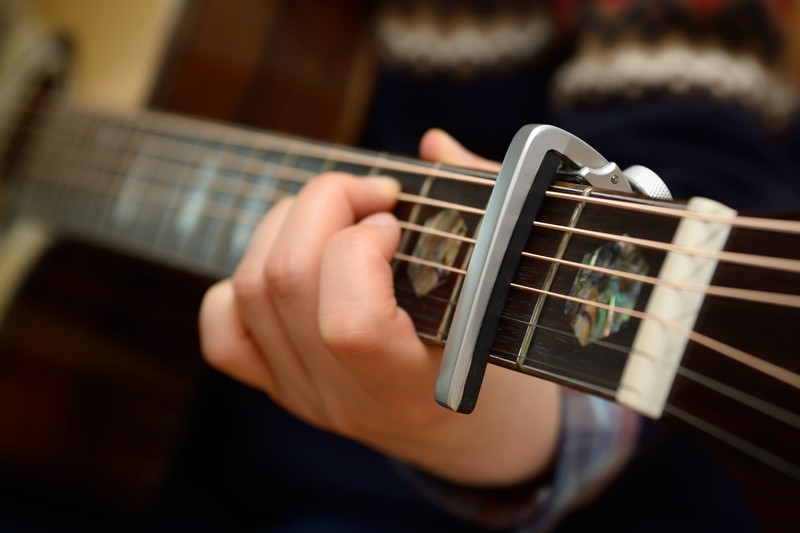It is no secret that a set of right pedals will completely change the quality of your performance. The difference they make is so profound, eventually, they become an integral part of our musical gear. For me, delay pedals are the ones that should be on every pedal board. They let you add texture to your sound, making it more unique and detectable.
On the quest of choosing the best delay pedals, you will have to consider a lot of factors. To make this process easier for you, this article will provide you with models that stand out on the market, as well as some tips on selecting the right pedal and the set of features you should look for. If you want to find the best suitable pedal for your music, just keep on reading.
What’s The Best Delay Pedal
| Image | Amplifier Model | ||
|---|---|---|---|
 | Source Audio SA260 Nemesis Guitar Delay |  (5 / 5) (5 / 5) | Check on Amazon |
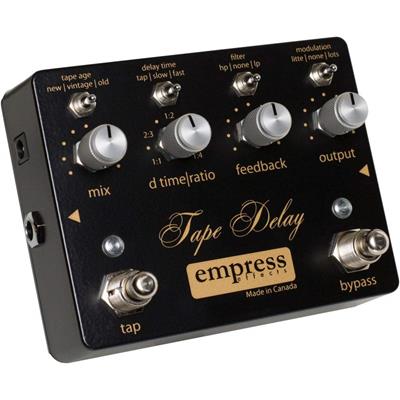 | Empress Effects Tape Delay Guitar Pedal |  (4.9 / 5) (4.9 / 5) | Check on Amazon |
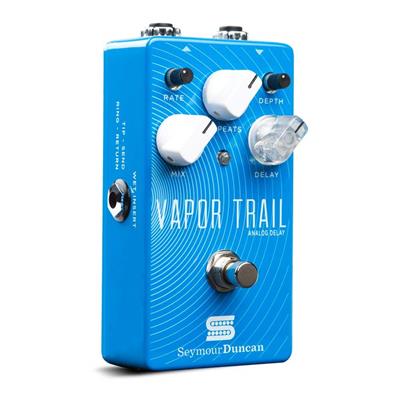 | Seymour Duncan Vapor Trail Analog Delay Pedal |  (4.8 / 5) (4.8 / 5) | Check on Amazon |
 | BOSS DD-7 Digital Delay Pedal |  (4.8 / 5) (4.8 / 5) | Check on Amazon |
 | Way Huge WHE701 Aqua-Puss Analog Delay |  (4.7 / 5) (4.7 / 5) | Check on Amazon |
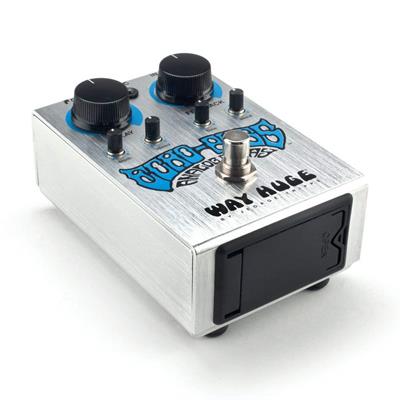 | Dunlop WHE702S Echo-Puss Analog Delay |  (4.8 / 5) (4.8 / 5) | Check on Amazon |
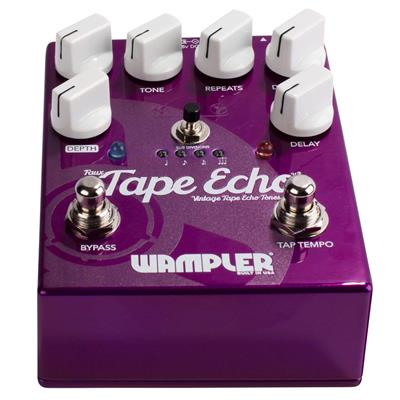 | Wampler Pedals Faux Tape Echo V2 Delay Pedal |  (4.8 / 5) (4.8 / 5) | Check on Amazon |
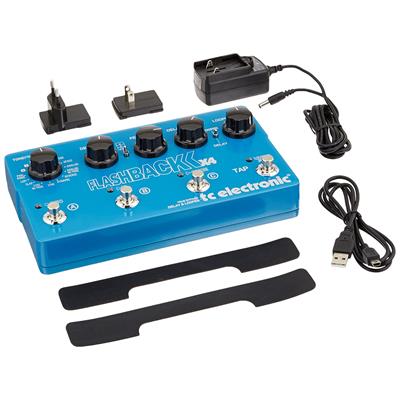 | TC Electronic Flashback X4 Guitar Delay Pedal |  (4.8 / 5) (4.8 / 5) | Check on Amazon |
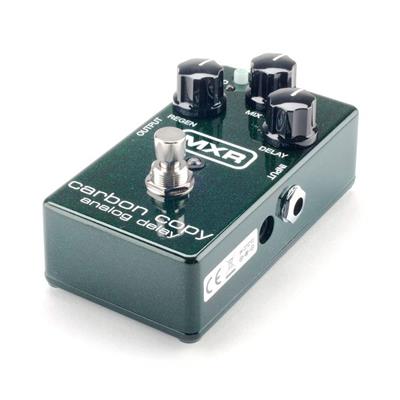 | MXR M169 Carbon Copy Analog Delay |  (4.8 / 5) (4.8 / 5) | Check on Amazon |
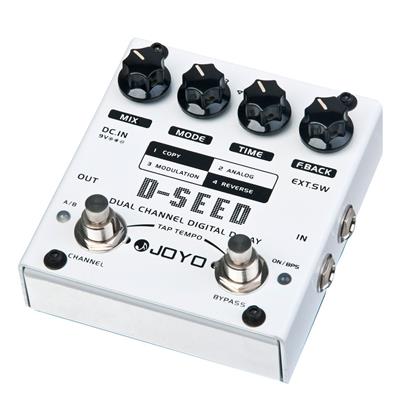 | JOYO D-SEED Dual Channel Digital Delay Pedal |  (4.8 / 5) (4.8 / 5) | Check on Amazon |
Source Audio SA260 Nemesis Guitar Delay

The Nemesis Delay is one of those pedals, that offer everything you could ever wish for. It is the mixture of various sound effects captured in a compact device. Nemesis consists of 24 effect engines ranging from digital and analog delays to advanced sweeper and rhythmic delays (and everything in between!). This variety of engines give you the opportunity to shift your sound with just a switch of a mode. This pedal also offers 128 presets, several delay taps, a hold function, tap tempo, full MIDI control, editing functions and universal bypass. Not to mention the typical Time, Mix, Feedback, Mod, Rate and Intensity controls, which add texture and depth to your sound. There is hardly anything you cannot create with this pedal. However, there is more. The Nemesis Delay comes with a free Neuro Mobile App, which lets you edit the sound and add more delays with a single touch of the screen. This pedal is a dream come true!
Pros:
- An abundance of features
- Editing functions
- Universal bypass
- Expression controls
Cons:
- Central engine control is made of plastic
Empress Effects Tape Delay Guitar Pedal

Empress Effects Tape Delay is a very compact pedal, stacked with features and capabilities. It features 3 types of tape age (new, vintage, old), which allow you to select how dark you want your sound to get. Filter and Modulation controls let you shape your sound according to your taste, while Delay Time monitors the amount of time between delays. Additionally, Tape Delay has a Tap Tempo and Ration knobs, that basically give you full control of your rhythms and make sure that they comply with your delays. You can also choose between True Bypass and Buffered Bypass with trails. Tap Delay offers you dry analog signal, but you can create wet signals with a twist of the Mix knob. Last but not least, this pedal has presets, that store your sound and let you play them back any time.
Pros:
- Versatile
- Killer sound quality
- Compact design
Cons:
- A bit difficult to use
Seymour Duncan Vapor Trail Analog Delay Pedal

Seymour Duncan Vapor Trail is a great example of a versatile analog delay. Equipped with Bucket Brigade Device (BBD), it sends the sound signal through multiple capacitors, which transforms the sound and adds the delay effect. It has a TRS insert jack, that lets you touch up your repeats with additional effects. Vapor Trail offers natural compression and smooths out the treble, turning your dry signal into a powerful wet sound. Like a typical delay pedal, it comes with Rate, Depths, Repeats, Mix and Delay knobs, that let you define your sound better. The part where Vapor Trail really shines is its modulation effects, adding shimmer and movement to your echoed tones. It is quite versatile and can be utilized along with other effects pedals, such as distortion, flanger, chorus and more. This pedal will become your go to device in no time.
Pros:
- Flexible modulation
- Great quality
- Warm delay tones
- Reliable
Cons:
- Does not offer a tap tempo
- Takes time to tailor to your preferences
BOSS DD-7 Digital Delay Pedal

BOSS is probably the first name you hear when you step into the music world. It is renowned for its quality products and DD-7 is no exception. It features several modes that give way to the versatility. Modulation Delay mode produces natural, chorus-type sounds, while classic Analog Delay mode replicates the warm tones of BOSS DM-2. Reverse Delay creates natural volume swells, reverses your signal and outputs it backwards. DD-7 offers expanded delay time up to 6.4 seconds, as well as tap tempo controlled via external footswitch. With Level, Feedback and Delay Time knobs you can control the volume, amount of feedback and time between delays. It also has a looping feature, recording up to 40 seconds of music, but do not expect it to be as advanced as other loopers. All in all, DD-7 has all the features of a classic digital delay pedal.
Pros:
- Extremely durable
- Has additional inputs and outputs
- Does not alter the tone
Cons:
- Modulation mode is not for everyone
- Can get noisy easily
Way Huge WHE701 Aqua-Puss Analog Delay

The Aqua-Puss Analog Delay adds a lot of depth and dimension to your sound. It can be controlled with three simple knobs. With a twist of a Delay knob you can go from 20ms delay to an extensive 300ms. The Feedback knob adjusts the intensity and duration of the delay. Blend control lets you find a silver line between dry and delayed signals. By setting the pedal to its extreme capabilities, you can turn it into a freaky monster. The Aqua-Puss creates all the sounds related to vintage analog delay and tape-based echo. With short delays and less repeats, you can create some unique rhythms. It has a classic “slapback” effect that amazes most of us. If you want your sound to be multidimensional and deep or you want a one trick pony, this pedal is definitely for you.
Pros:
- Simple
- Responsive
- Steeped tone
Cons:
- Short delay time
- Does not have a tap tempo
Dunlop WHE702S Echo-Puss Analog Delay

The Way Huge Echo-Puss was designed by Jeorge Tripps, an expert of delays. This pedal generates an organic analog delay and features a simple user interface. Its Bucket Brigade Device chips provide you with 600ms of delay. LFO modulation circuit makes your dry signal quite drenched. The Delay knob sets the delay time, while the Feedback control adjusts the number of repeats. Tone and Blend knobs let you modify the definition of the repeats and wetness/dryness of the delay signal. The two remaining knobs – Depth and Speed- are relatively self-explanatory: they control the speed and depth of the modulation circuit. All in all, Way Huge Echo-Pass can give you a warm, low-frequency repeats, as well as generate mild chorus effect.
Pros:
- Warm tones
- Compact
- Easy to use
Cons:
- Chorus is not very effective
- Sucks the battery out
Wampler Pedals Faux Tape Echo V2 Delay Pedal

Just like its predecessors, Wampler Faux Tape Echo V2 offers the clear sound signal and deep repeated tones. It has added sub divisions on the Tap Tempo, which allows you to control your delays even better. Faux Tape Echo V2 is a hybrid of digital and analog delay pedals. This means that your delay will be longer (due to its digital nature), while maintaining the warmth and purity of analog delays. It is worth noting, that most parts of the pedal are still analog, with the delay line being a single digital element. The sound this pedal generates is absolutely defined and focused, with all the tape delay effects. Faux Tape Echo V2 is the best of both worlds, featuring Tone, Repeats, Delay Mix, Delay, Depth and Rate controls (the latter two acting as modulation).
Pros:
- Vintage
- Warm tones
- Easy to adjust the tone
- Precise sound
Cons:
- Might develop “white noise”
TC Electronic Flashback X4 Guitar Delay Pedal

TC Electronic Flashback X4 offers a wide range of effects. Its enabled TonePrint offers 16 different delay types which take the versatility to a whole new level. It features Tape and Analog delays, as well as Ping Pong, Reverse and many other effects. Tap Tempo provides you with a full control of the rhythm. Flashback X4 has 3 preset footswitches, which allow you to swap between delay sounds in no time. Additionally, it has a 40 second looper (with undo/redo features) for adding delay to your loops. True bypass guarantees total clarity and zero signal loss when the pedal is off, while optional Buffered Bypass prevents high frequency loss. Expression pedal and MIDI inputs allow you to adjust the parameters remotely. Flashback X4 is a great sounding pedal by all measures.
Pros:
- Wide variety of delay effects
- Clear tone
- Enabled TonePrint
Cons:
- Takes up a lot of space
- You cannot save your loops
MXR M169 Carbon Copy Analog Delay

MXR M169 Carbon Copy is a true analog delay pedal, which is quite simple to use. It offers a Modulation effect which can be activated with a simple push of the Mod button. This adds more body and depth to your signal and creates a chorus-like tone (depending on the settings of course). Mod is a bit hard to adjust, since you have to open up the pedal to access two trimpots that modify the modulation effect. This might be an issue for you if you do not like taking apart your brand-new devices. Just like many other pedals, MXR Carbon Copy has a True Bypass, preventing you from the loss of the signal. This pedal has three main knobs: Regen knob modifies the amount of your delay repeats, Mix control balances your wet and dry signals, while Delay knob adjusts the time between your delays. Keep in mind that maximum delay with this pedal is 0.6 seconds. In short, MXR Carbon Copy does exactly what it says and gives you deep analog tones.
Pros:
- Added modulation mode
- Easy to use
- True bypass
Cons:
- Modulation cannot be accessed by foot
- You have to take apart the pedal to adjust modulation effects
JOYO D-SEED Dual Channel Digital Delay Pedal

If you are looking for the best inexpensive delay pedal, JOYO D-SEED was made for you. It is a very flexible pedal offering a great sound. It has a built-in Tap Tempo function that allows you to control the delay time independently. The distinguishing factor of this pedal lies in the capabilities of its two presets: each of them can store individually chosen delay time. This makes it even easier to apply effects to your sound. What is more, JOYO D-SEED features four types of delay: Copy reproduces the original sound of your instrument without interfering with it, Analog creates warm delay tones (with 0.6 seconds of delay time), Modulation generates a rich spatial sound, especially with clean tones and Reverse allows you to add a psychedelic touch to your music. On the whole, JOYO D-SEED can produce a quality sound and can be purchased without breaking the bank.
Pros:
- Affordable
- Thick tones
- Flexible
Cons:
- Tap Tempo sets the delay time to maximum automatically
- Not the highest quality
Digital vs Analog Delay
The dichotomy has existed between digital and analog delays since the very first days of their creation. Nothing splits the musical world as these two bad boys. However, it is only natural to question, what is the big difference between them. I will try to explain each of them and clear up all the incoherent conceptions lingering in your mind.
Typically, analog delay pedals count on Bucket Brigade Device (BBD) chip, which transfers the analog signal through multiple sets of capacitors. The signal that passes through those chips usually becomes warmer and diffuses more and more with each step, creating a smooth tone with rich sonic quality. While BBD chips make analog delays unique, they limit it as well: pedals of this ilk are prone to have shorter maximum delay time compared to digital delays.
Meanwhile, digital delay pedals utilize Digital Signal Processing (DSP), which means they are more flexible in terms of construction. Manufacturers can adjust the transparency and the length of the signals to their taste. In order to produce the desired effect, sound signal has to undergo several transformations: at the input it is converted from analog to digital (through A/D converter), is sampled and blended back with the dry signal considering the desired delay time. And finally, it is converted again from digital to analog (through D/A converter) at the output. Due to this character, the sound generated by digital pedal can be a bit cold or harsh. Analog delays work similarly as well, except for the fact that they skip the entire step of conversion (thanks to BBD chips).
When it comes to the differences in sound, both can distort the sound. However, the subtle distortion at the output of analog delay is considered as a good thing, because it thickens the sound signal and adds a certain character to it. The distortion that occurs in digital delays is not very pleasant and is rarely desirable for the musicians.
In the early days of development, digital delays were not as distinctive and “good” as it is nowadays. Manufacturers started to improve the sound quality by resembling analog sounds. They stepped up their game by improving resolution, using better A/D and D/A converters and equipping digital delays with all-analog side chains. This made it possible to capture all the unique features of analog delay and generate it through digital pedals. Nowadays, it can be stated that the latter offers more versatility and flexibility, allowing you to travel from warm BBD delays to rich Tape delays and pristine digital delays with your sound.
Predictably, the BBD chips are becoming less and less available, which might turn analog delay pedals into shadows of the past. Their sound still remains just as great as it used to be and for now the danger of the distinction of analog pedals seems like a far-fetched future.
What kind of delay works with specific genres
No matter what kind of devices you are looking for, the very first thing you should always consider is the genre of your music. As for digital and analog delays, they will be best suited for different styles of music and that does not make any of them bad. The other thing that will determine your choice, is what you want your pedal to do with your sound. I will list several music genres below and give you some suggestions accordingly.
- If you play blues, jazz, country and classic rock, it is likely that you prefer vintage tones. For this, analog delay pedal will be the best match, since it will provide better reproduction of the sound.
- If you prefer surf music and psychedelic rock, you will need an analog delay. That is exactly what the great musicians of late 1960s and 1970s would use in order to generate those distinguished sounds.
- For those who play metal, grunge, modern hard rock and everything in between, digital delay will become an integral part of your pedal board. It provides more flexibility to really enhance your sound and give more dimension to it.
It is totally up to you what kind of delay you will choose. The list I have provided will just give you a general understanding of what combinations work best. But keep in mind that these are not rules and you can be as adventurous as you want when it comes to your sound.
How to choose a delay pedal
After we have discussed all the factors related to analog and digital delays, let’s dig into the specific characteristics of delay pedals. There are certain features that can never be overlooked and even shape the way you assess a delay pedal.
First things first, what are the key factors that determine your choice? Thanks to the plethora of delay pedals on the market, you can select the one that was made for you. But how to find the one? Generally, factors such as affordability, versatility, flexibility, precision, quality and size interfere with your choices. Think carefully about each of them and answer simple yes or no questions to determine, what matters to you, for example, does price play the most important role or is the versatility the main quality you are looking for? This will quickly filter out the options in your mind and dictate in what direction you should continue your search.
Now, after we have figured out what you are looking for, let’s take a look at the features, that make a good delay pedal.
Tap Tempo
Tap Tempo is basically a switch that you press repeatedly to set the delay time. It allows you to be more precise and is great addition if you play rhythmic music. It makes sure that your delays are spread evenly in time, which adds a little bit of precision to your tones. Not having a Tap Tempo is not a deal breaker, if your pedal can save your presets. All in all, this feature is very useful and can significantly improve your performance.
Control
This feature will be especially important for perfectionists and professionals, who take their sound very seriously. Typically, almost every pedal has three basic controls: Delay Time, Feedback and Level. But more advanced pedals offer a bunch of other knobs, such as depth, speed, filter and etc. that let you shape your sound the way you would craft a clay figurine. The more controls a pedal has, the more defined and precise is the sound you generate.
Editor
Nowadays, many pedals provide you with the opportunity to connect to a smartphone or a computer and utilize the editor to adjust the settings or add even more effects to your tone. This is probably the most personal and subjective feature, because not everyone wants to overcomplicate the process of playing with even more devices. It is a good thing to consider, but not having it will not rack your world or detriment you from the ability to create amazing and precise tones.
Multiple Delay Types
Who does not love paying money for one pedal but receiving the features of the multiple? Many pedals offer different types of delays, which saves you a lot of money and space on your pedal board. They are equipped with several delay engines, that can be switched with just a twist of the knob (for example, Source Audio Nemesis or TC Electronic Flashback X40). Not only is it convenient, but it also provides you with a lot of flexibility and versatility. One delay pedal that has it all. What else could you wish for?
There are more features that your pedal can have, but these are the ones that interfere with your tone the most. Having them all combined in a single delay pedal, will make it easy for you to dial in any desirable sound. After all, engineers discover new things for one simple reason: they strive to simplify and improve our lives.
Conclusion
Hopefully, now you have a general outline of your preferences and things, what will make it easier to find the best delay pedal. It might be a little overwhelming, but trust me, the more you know, the better choice you will make. I wish I could tell you that you can pick out the most suitable pedal for you just by reading about it. You will never know unless you plug in. Try as many pedals as you can until the sound you hear is right. I have given you a lot of options to choose from. Unfortunately, my mission ends here. The rest is up to you!




